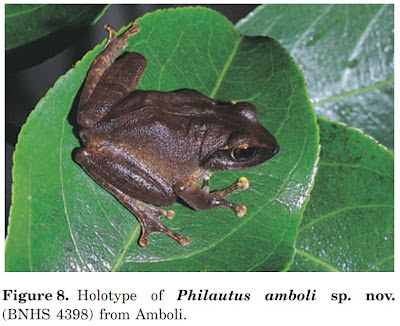
Pseudophilautus (Philautus) amboli sp. nov.
& P. kani sp. nov. Biju & Bossuyt. 2009
Abstract
A taxonomic account of the genus Philautus from the Western Ghats of India is presented. All known species of this genus, their type specimens, current taxonomic status, and geographical distribution are revised, based on museum and field studies. In addition, 12 new species are described and compared with other members of the genus, especially with the name-bearing types of Indian Philautus. Diagnoses, detailed descriptions, illustrations, data on distribution, and natural history are provided for all species, and their relationships are estimated using molecular phylogenetic analyses of mitochondrial data sets. No reliable observations have been made for two species, Philautus chalazodes (Günther, 1876) and Philautus flaviventris (Boulenger, 1882), since the original descriptions in the 19th century.
KEYWORDS: biodiversity – biogeography – molecular phylogenetics – taxonomy.

Philautus amboli sp. nov. can be easily differentiated from all of the known species of Philautus from the Western Ghats by its dark-brown tympanum (both in life and in preservation), in combination with a relatively larger snout–vent length (Figs 8, 9). However, because of the tympanum coloration, P. amboli sp. nov. could be confused with two other species that have dark-brownish black tympanums from this region, Philautus kani sp. nov. and Philautus wynaadensis Jerdon, 1853, and three species from Sri Lanka, Philautus leucorhinus (Lichtenstein & Martens, 1856), Philautus nasutus (Günther, 1869), and Philautus temporalis (Günther, 1864). Philautus amboli sp. nov. differs from P. kani sp. nov. and P. wynaadensis by the relatively larger snout–vent length of the adult male (Fig. 9), SVL 31.1 ± 2.3 mm, N = 9 (vs. the small adult male SVL 20.6 ± 1.5 mm, N = 7, in P. kani sp. nov.; medium adult SVL 25.7 ± 1.5 mm, N = 7, in P. wynaadensis), rather robust body (vs. slender in both species), throat lemon yellowish with black spots (vs. fleshy white or grey in P. kani sp. nov.; light-greyish yellow with minute spots in P. wynaadensis), restricted distribution in Maharashtra and Karnataka states (vs. both species endemic to Kerala and Tamil Nadu).
Etymology: Named after Amboli, where the type series was collected. Amboli is treated as an invariable noun in apposition to the generic name.

Distribution and natural history: Amboli and Amba in Maharashtra; Castle Rock, Londa, Jog FallsMavingundi, and Kudremukh-Malleshwaram in Karnataka, (Fig. 6B, Table 1). Five out of seven specimens from the type series were collected from the ground near disturbed evergreen forest patches. The remaining two were collected in amplexus from vegetation about 1-m high. The vocal sac is large and transparent when calling. All were collected during a rainy evening after 19:00 h.

PHILAUTUS KANI SP. NOV.
(FIGS 2, 9, 38D, 43A–D, 44A, B; TABLE 2)

Philautus kani sp. nov. is similar to P. amboli sp. nov. and P. wynaadensis from the Western Ghats (Fig. 9). For differences with P. amboli sp. nov., seethe ‘comparison’ of that species. Philautus kani sp. nov. differs from P. wynaadensis by its short male snout–vent length, SVL 20.6 ± 1.5 mm, N = 7 (vs. medium, SVL 25.7 ± 1.5 mm, N = 7), snout sharply pointed in ventral view (vs. snout subelliptical), canthus rostralis rounded to sharp (vs. indistinct), shank almost equal to thigh, ShL 10.5 ± 0.6 mm vs. TL 10.3 ± 0.5 mm, N = 7, male (vs. shank longer than thigh, ShL 13.4 ± 0.7 mm vs. TL 12.6 ± 0.7 mm, N = 7). Comparison of members of the Sri Lankan Philautus radiation with Western Ghats species is provided under P. amboli sp. nov.
Etymology: The species is named after the Kani tribe of Chathankod of Kerala who live where the type series was collected. SDB enjoyed tremendous field support and guidance from the Kani tribes, particularly Mallan and Vijayan, for his field studies of the Western Ghats amphibians.
Distribution and natural history: One of the most common species in South Kerala and Mundanthurai (Tamil Nadu). It has been located and /or collected from Bonakkad, Chathankod, Kiriparai, Neyar, Palode, Ponmudi, and the foothills of Agasthyamala (Fig. 38D, Table 1). The type series was collected from about 0.5-m high in the vegetation of secondary forest patches near the Kani tribal settlement at Chathankod.
Remarks: This species was identified as P. temporalis (FMNH 218129, an adult female; FMNH 218125 and FMNH 218124, two adult males) from Ponmudi and as P. variabilis (FMNH 212990) (Inger et al., 1984). Six specimens were found in the ZSIM from ‘Kalakkad’ Tamil Nadu, without any number and labelled as P. leucorhinus.
Biju, S.D. & F. Bossuyt. 2009. Systematics and phylogeny of Philautus Gistel, 1848 (Anura, Rhacophoridae) in the Western Ghats of India, with descriptions of 12 new species. Zoological Journal of the Linnean Society, 155: 374-444. : DOI: 10.1111/j.1096-3642.2008.00466.x

